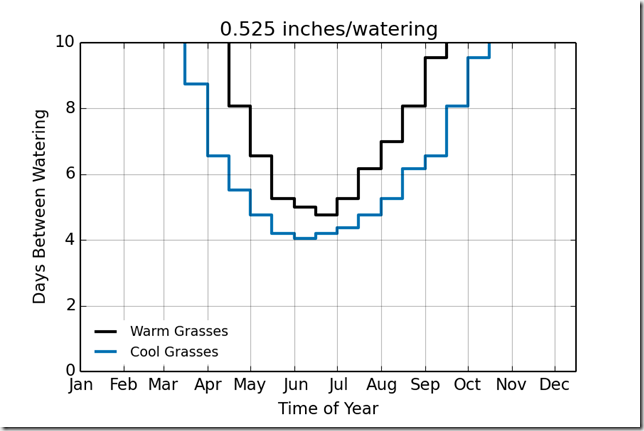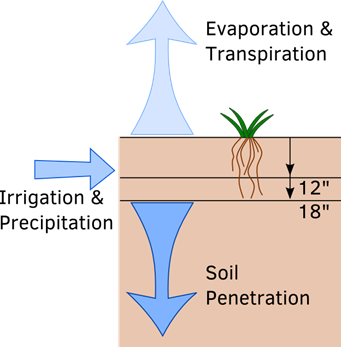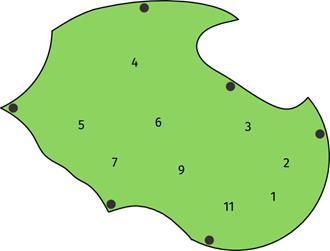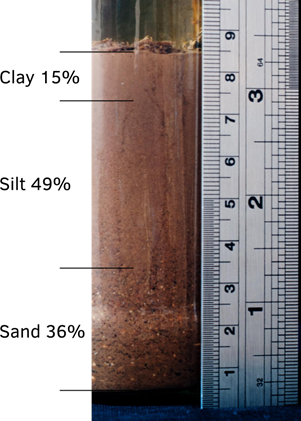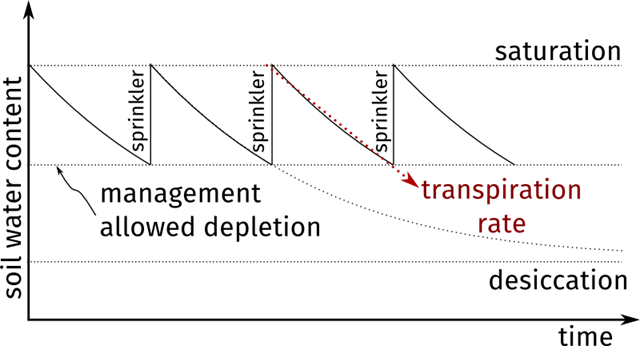In central New Mexico there is not enough rainfall to grow a lawn. Water is precious—and expensive. A responsible homeowner maintains his lawn with no more water than required. But how much is required?
You can calculate the amount. Guide H-504 from the New Mexico State University cooperative extension How to Water Your Lawn shows how to calculate water usage, but it is confusing. To make this easier, I approach the problem from the point of view of a homeowner. A homeowner controls two things in an established lawn:
Watering frequency
Duration of each watering
The duration of each watering depends on how much water the soil can hold down to the root depth, how much water is in the soil when watering starts, and how fast the sprinklers deliver the water. The watering frequency depends on the rate water leaves the soil.
Water enters the lawn mainly from irrigation, but it leaves the lawn into the earth through seepage and into the air through transpiration and evaporation. Water leaves both up and down, but most of the loss is upward through transpiration and I will neglect downward loss.
Of the two controls, the watering duration requires knowing the how fast the sprinklers deliver water, and how much water is needed to soak the ground to the root depth. First, the speed at which the sprinklers deliver water. I measured this by putting eleven tuna cans distributed over the surface of the lawn, and letting the sprinklers run for 25 minutes. I measured the amount of water in each can, and calculated the average flow rate and the standard deviation over the surface of the lawn. My sprinklers deliver 0.75 ±0.28 inches per hour. A standard deviation of almost 30% is fairly uneven coverage, so the best strategy for me is to assume the low end of the range, about 0.5 inches per hour.
The next question is how much water is needed to soak the ground. The amount of water depends on the rooting depth—how deep the water has to go, and on the amount of water the soil can hold, both properties of the soil. The grass’ rooting depth depends on the grass type. Turf grass types in New Mexico are classified as cool season or warm season. Warm season grasses will stay brown longer into the spring, tolerate less foot traffic, and use less water over the year than cool season grasses. My lawn includes a section of grass with short leaves that grows long runners. It stays brown until the middle of May and turns brown in November. I’ve always called it Bermuda grass because it looks like the Bermuda grass I see in San Diego, but I’m no botanist. The majority of my small lawn is cool season, it stays green throughout the year, though it is not vibrant through the winter. Kentucky bluegrass and tall fescue are cool season grasses. According to New Mexico State University’s Circular 660, cool season grass has a rooting depth of about 18 inches.
The soil type governs three important parameters: the water holding capacity, the infiltration rate, and the management allowed depletion. The infiltration rate is only important to control puddling, and I have never been able to form puddles on my lawn with a sprinkler. The other parameters, however, are important. Therefore I set out to measure my soil’s type.
Soils are defined by a three-element mixture model; that is, a soil is defined by what fraction is clay, sand, or silt. One way to measure the soil content is to make a suspension and measure the layers that precipitate. I put about three quarters of a liter of soil in a jar, filled it with water, and shook it. The jar resulted in three layers.
| Clay | 15% |
| Silt | 49% |
| Sand | 36% |
Purdue defines soil type by a mixture model and also shows a technique for determining soil type based on mud plasticity. I used the layer thickness in the photo along with the ternary plot from Purdue to determine that my soil is a medium loam. I estimated the parameters of the soil and used Purdue’s soil model ternary plot to estimate the soil type.
With my soil type, medium loam, I looked up the soil properties in Circular 660 to get infiltration rate (0.75 in/hr), available water (1.5 in/ft), and management allowed depletion (50%). Management allowed depletion is the fraction of the soil’s water capacity that can be lost before plants are stressed.
| Infiltration Rate | 0.75 in/hour |
| Available Water | 1.4 in/foot |
| Allowable Depletion | 50% |
I believe my measurement overestimates the clay content, and that my soil’s behavior is more sand-like. To address this I use a water capacity margin factor to reduce the assumed available water content by half.
The amount of water to apply during a cycle is the amount needed to increase the soil moisture from its management allowed depletion up to capacity. In formula it is
Water to Apply [in] =
(Available Water [in/ft]) × (MAD [%]) × (Root Depth [ft])
To calculate the duration of the sprinkler run, just divide the
applied water by the sprinkler rate
Duration [min] = (Sprinkler Rate [in/min]) × (Water to Apply [in])
I calculate that an irrigation should last 67 minutes, the
necessary time to get 0.5 inches.
Finally, I need to determine the frequency of watering. Frequency of watering depends mainly on the rate water leaves the soil. In turn, the rate water leaves depends on the climate. The following schematic shows the process. The transpiration depletes the soil of moisture. The rate of moisture loss is, probably, non-linear in general but approximately linear at first.
The evaporation and transpiration rates are estimated in Circular 660
for Albuquerque. The following figure shows the data, and shows
that the peak rate of loss is in the first or second week of June.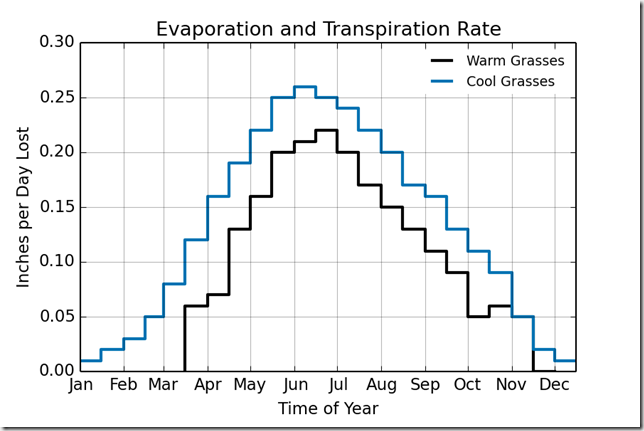
By using the assumption of linearity, I can calculate the days between
watering. If ET is the evaporation and transpiration rate, then the
days between watering can be estimated as
Watering Interval [day] = (Water to Apply [in]) × (ET [in/day])
My watering interval, in the following figure, shows the variation over the course of the year. Albuquerque public works recommends watering three times a week at the peak of the season. My calculations suggest watering only twice a week. Albuquerque’s recommendations
conspicuously lack a recommended time, or amount of water. Perhaps my calculation recommends a longer time than the Albuquerque.